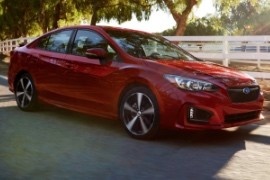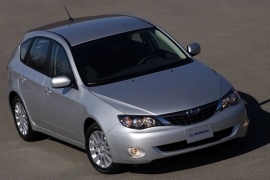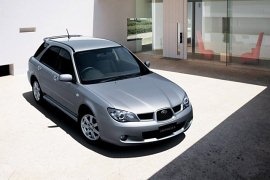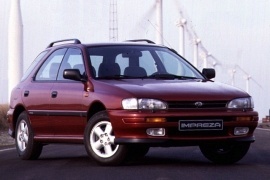
SUBARU Impreza
Generations Timeline, Specs and Pictures

In a market with a varied choice of small sedans, the Impreza stood out with its standard all-wheel-drive system.
Among the roomiest vehicle in the segment, the Impreza had a nicely designed cabin and came with a great suspension to make sure the occupants were not bothered by poorer roads.
Available as a small sedan or hatchback, the Impreza came in three trim levels: the 2.0i, the 2.0i Premium and the 2.0i Limited. The hatchback version added two extra sportier trim levels.
The base model was well equipped with 15-inch wheels, power accessories, air-conditioning, cruise control and even a rearview camera that was usually given as optional for most of the vehicles on the market, a trip computer, Bluetooth connectivity, a 6.2-inch touchscreen and a 4-speaker audio system.
The Premium trim level added bigger alloys, an extended list of exterior paint colors, chrome interior door handles and an upgraded audio system.
The Limited trim level included all options available with the first two trim levels and added automatic headlights, foglights, automatic climate control, leather upholstery, a bigger touchscreen and options such as a sunroof and a navigation system.
The sportier versions added roof rails, special design cues and others.
Over the years, Subaru became most known for the all-wheel-drives vehicle that were a great choice to adventurous people and the 2015 Impreza was no exception, while still offering comfort and great room.

Subaru unveiled the fifth generation of the Impreza at the New York Auto Show in 2016, and it made the car available as a sedan or hatchback right from the start.
The fourth generation of the Impreza was on the market for only five years before Subaru replaced it. It was unusual for a carmaker to make that fast changes. Worth mentioning that the 2011 Impreza was facelifted in 2014, and it didn’t look outdated two years later. But the Japanese carmaker had other ideas.
The sedan version shared the front fascia with its hatchback brother. With its streamlined, swept-back headlights and a black-mesh grille at the front, the 2016 Impreza showed a clear statement for other sporty sedans from the market. The turbocharged versions featured a hood-scoop to show its muscles, especially for the WRX and WRX STI versions. Since it was a three-box sedan, it was longer than its hatchback sibling but featured the same wheelbase.
Inside, Subaru installed sport bucket seats at the front with high bolstering. The dashboard showed greater attention to detail paid by Subaru’s designers and an infotainment unit on top of the center stack. Above that, the carmaker installed an additional screen for the onboard computer for selected models. But all Imprezzas received a center console with a center storage compartment under the front armrest. In the back, Subaru installed a 60/40 split-folding bench for three. Its separate trunk was good for 348 liters (12.3 cu-ft), which was kind of small when compared to the rest of its competitors.
Under the hood, Subaru installed only one engine for the regular sedan version. The other options were the WRX.

The Subaru Impreza was redesigned for 2012 with the aim of attracting a wider range of customers.
Thew new model was available as a sedan or a hatchback body shape. The sedan was available in three trim levels: 2.0i, 2.0i Premium, 2.0i Limited, and the hatchback added two more: 2.0i Sport and 2.0i Sport Limited. The high-performance models, namely the WRX and the STI were not renewed for 2012.
The base Impreza had standard 15-inch wheels, keyless entry, air-conditioning, a trip computer and a 4-speaker sound system. The Premium trim level added bigger alloy wheels, fog lamps, cruise control, Bluetooth connectivity for both phone and audio. 2 additional packages were available, the Alloy Wheel package and the All-Weather package, the first adding 17-inch wheels and a leather-wrapped steering wheel, while the latter added heated mirrors and heated front seats.
The Limited trim level included the features coming with the Premium and added automatic climate control, leather upholstery, automatic headlights and a touchscreen display.
The hatchback’s specific Sport trim level included 17-inch wheels, roof rails, different upholster and the standard All-Weather package.
The 2012 model featured a 2.0-liter engine that produced 148 hp. It could be mated with a 5-speed manual transmission as standard, or the available CVT gearbox that promised to have the best fuel efficiency.
Safety was at a high standard for the 2012 model, with standard stability and traction control, antilock brakes, front and side airbags, as well as head restraints and a driver knee airbag for the 2.0i models.
One of the biggest changes for 2012 was represented by the Impreza’s new interior, completely different and upgraded compared to the previous generation. Soft-touch materials were used for the dashboard and the door sills, with an overall clean and elegant look.

The Subaru Impreza represented a good alternative to other small sedans and hatchback in its class, with its standard all-wheel-drive system and an impressive safety record.
For 2012, Subaru redesigned the Impreza to make it more attractive. The new styling brought the Impreza closer to Subaru’s Outback and Legacy.
While the exterior design was not considered very flattering, the major updates were found under the hood.
The 2.5-liter 4-cylinder engine that was mounted on the previous generations was replaced by a 2.0-liter 4-cylinder powerplant that cranked out 148 hp. While the new engine was less powerful, it offered great fuel economy.
The sedan version came in three trim levels, while the hatchback added two more.
The base trim level included 16-inch wheels, keyless entry, air-conditioning, a trip computer and a 4-speaker audio system.
Moving up the trim levels, the 2.0i Premium added 16-inch alloys, cruise control, foglamps, Bluetooth phone and audio connectivity, a 6-speaker audio system and steering-wheel mounted controls. Available for the 2.0i were he Alloy Wheel package that brought bigger 17-inch wheels with a leather-wrapped steering wheel, and the All-Weather package that included heated mirrors and heated front seats.
The 2.0i Limited included the packages mentioned above and added automatic headlights, leather upholstery, a touchscreen display, as well as a rear center armrest.
The 2.0i Sport Premium came with 17-inch alloys, two-tone body color, all new upholstery, roof rails and the heated mirrors and front seats.

The 2007 version of Subaru Impreza marks the beginning of the third generation of the car, being officially introduced in 2007 at the New York Auto Show.
Assembled in Gunmna, Japan, the new Impreza is available in multiple engine versions powered by both gasoline and diesel. Moreover, Subaru worked on the safety of the vehicle and equipped it with stability control as well as with airbags and improved impact protection. That’s why the new Impreza gained a 5 start Safety Rating as well as a 4 star Pedestrian Safety rating during the last ANCAP crash testings.

Unlike the previous release, the 2005 Subaru Impreza is actually a real facelift, the base model being improved with a new interior and a couple of new features which were not installed on the earlier models.
First of all, the new Impreza has a new console and door panels while the materials used inside the car were also changed. Moreover, Subaru installed an automatic air conditioning system on the WRX and STi versions. Beside all these improvements, the Japanese manufacturer introduced the Outback Sport Special Edition, a new version of the car which had a refreshed interior, a pre-installed rear spoiler and the above mentioned CD changer.

Subaru introduced the Impreza’s second generation in 2000 and added two facelifts for it in 2002 and 2007.
Just two years after the car’s launch, Subaru changed the front fascia to calm the spirits. It managed to create a better-looking car with that. But it felt like it could do more. This time, the design department had more time to design it.
The so-called “hawkeye” version came with a completely redesigned front end. The carmaker introduced a new grille that paid homage to its former parent company, Nakajima Aircraft. Its grille evoked the first jet-engine aircraft built in Japan, with the middle section resembling the fuselage and flanked by two jet engines. Its headlights featured curved lines combined in sharp angles, similar to a hawk eye. In the back, Subaru changed the taillights and moved the clear-lens reversing lights at the lower part instead of the upper side from the 2000 and 2002 versions.
Inside, the carmaker kept most of the interior parts from the 2000 model, but it added new materials and a few changes. Subaru changed the buttons for the climate control unit on the center stack and, depending on the option, changed the sound system with a better CD-stereo.
Under the hood, Subaru changed the engine lineup. There was a new 1.5-liter engine that replaced the older one and a new 2.5-liter unit for selected markets. Both were naturally aspirated and featured a low-range gear to help the driver when pulling a trailer. For the turbocharged WRX version, the carmaker used the 2.5-liter flat-four engine and increased the power over its predecessor.

Subaru introduced a much-awaited facelift for the Impreza range in 2003 and got rid of those ugly headlights that earned its name as the “bugeye.”
Let’s face it! The Subaru customers never bought an Impreza for their design, or otherwise, the car would have died after the first generation. They bought it for handling, powertrain, reliability factor, and almost anything else. But not for the look. After the 2003 facelift, Subaru was surprised to discover that the refreshed design attracted more buyers into its showrooms.
The new front fascia was miles ahead of what its non-facelifted version had to offer. Its more sweeping headlamps, deeper grille with a horizontal slat resembled an airplane wing, and the sporty-looking apron completely transformed the car’s look. For the non-turbo version, there was no hood-scoop. That was reserved for the turbocharged versions. The taillights kept a similar design as the non-facelifted version, but with a round lamp for the fog-light.
Subaru tried to play it safe and upgraded the interior as well. It was like an entirely new generation, with bigger turning knobs for the HVAC system. The driver received a three-spoke steering wheel instead of the older, four-spoke one. Like its predecessor, the Impreza Wagon featured a split-folding rear bench.
The carmaker tuned the previously used engines and added a new version with a 2.5-liter displacement that provided 165 hp. For the U.S. market, the carmaker offered the Impreza exclusively with an all-wheel-drive system.

Based on the same platform as the Impreza Sedan, Subaru developed the Wagon to offer more trunk space, so the husbands could claim that they bought a family vehicle.
Subaru became a highly successful vehicle due to the World Rally Championship, where it gained a great image. Despite its look, the car was rock-solid on the reliability index and great on slippery surfaces, regardless of the engine version.
While the engineers burned the midnight oil, Subaru’s designers seemed to be off-duty, and the car’s design was one of the most unsuccessful ones in the brand’s history. Its big, round headlights attracted the nickname “bugeye.” A pair of big fog-lights was installed on the lower part of the bumper, depending on the trim level. The station wagon version featured a longer hood with an additional set of windows behind the rear doors. To cut costs, the carmaker fitted the exact same frameless doors as the sedan version.
Inside, the Impreza Wagon kept the same bolstered seats for the front passengers or sport-bucket seats for the WRX version. In the back, the carmaker installed a split-folding bench, which could expand the trunk space.
Under the hood, Subaru installed a small choice of three engines ranged between 1.6-liter and 2.0-liter. While the all-wheel-drive system was fitted as standard for the latter, the former was offered with front-wheel-drive as well.

Subaru introduced the Impreza lineup in 1993 as a replacement for the Leone, and it brought a station wagon version as well, which was refreshed along with the rest of the range in 1998.
The Impreza was already a renowned name on the market after its first rally victories, and the GT-Turbo version started to be more appreciated on the streets. Thanks to its all-wheel-drive system, the car proved its qualities, especially on mountain areas and on loose and snowy surfaces.
The 1998 model sported a new front fascia, with a slim reversed trapezoidal grille that replaced the previous flat panel that blocked most of the space between the hood’s edge and bumper. Subaru also replaced the bumper, which featured a broad grille in the apron and two side-scoops where it installed the fog-lights. The turbocharged version featured an air-intake and four vents on the hood, plus two big, round headlights on the bumper.
Inside, Subaru completely changed the dashboard. On the 1998 model, the center stack featured a flat panel for the HVAC controls and the stereo. It followed the Japanese styling with the climate controls installed on the upper side, making it difficult to access the controls for the sound system. In the back, Subaru installed a folding bench which expanded the trunk from a mere 356 liters (12.5 cu-ft) to a decent 1275 liters (45 cu-ft).
Subaru ditched the older 1.8-liter engine for the drivetrain and kept only three engines ranged between 95 hp and 218 hp.

Subaru introduced the Impreza lineup in 1992 as a replacement for the Leone, and like its predecessor, it built it as a station wagon as well.
The carmaker finally decided to use the Legacy platform for a smaller, compact-segment vehicle like the Impreza. It also to dropped the wedged shapes from the early ’80s and switch to the rounded shapes of the early ’90s before the biodesign trend. But it did even more.
For the Impreza Wagon, the carmaker tried to keep as many common parts with the sedan. That wasn’t an easy task since the car didn’t have rims for the side windows. At the front, it kept the narrow fascia with slim headlights and grille. Since the engine was flat, it made a lower profile for the hood and a taller bumper which integrated an additional grille. In the back, the Impreza Wagon featured a raked-forward tailgate, which was parallel with the C-pillars. It lost something for the trunk space but won more points on the aspect side.
Inside, the carmaker installed a functional and simple interior with a minimalist design. Its dashboard featured a rounded instrument cluster and a center stack with the climate control dials on the upper side and the radio on the lower part. Depending on the trim level, the car featured an AC unit and radio cassette player. The cargo volume ranged between 357 liters (12.6 cu-ft) with all the seats up and 1,755 liters (62 cu-ft) with the rear bench folded.
Under the hood, Subaru installed a small range of flat-four engines ranged between 1.6- and 2.0-liter, depending on the market. Later on, a turbocharged flat-four was added to the range. The base version was available with a front- or all-wheel-drive system.























































